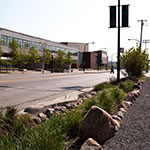One of Chicago’s most iconic features is its skyline, as some of the world’s tallest buildings provide a backdrop to 18 miles of recreational Lake Michigan shoreline. But the public right-of-way—streets, sidewalks, bike lanes, and adjacent utilities space, all radiating westward from the lakefront—consumes 23 percent of the city’s land area. Green buildings count for a lot, but greening Chicago’s 6,100 miles of avenues, boulevards, roads, and alleys is another challenge that shouldn’t go overlooked.
On the city’s Near South Side, it isn’t. In 2011, the Chicago Department of Transportation (CDOT) built what it has described as “America’s greenest street.” The Cermak Road / Blue Island Avenue “complete street” project impressively reduces the urban heat island effect, vehicle-exhaust smog, and flooding. The sustainable streetscape also provides inviting sidewalks for pedestrians and bus passengers and safer travel for bicyclists.
The strategies that went into the project represent a holistic approach to road building, providing lessons for urban planners everywhere. But equally instructive is how the project was accomplished bureaucratically and for less money than traditional street renovations. In older metropolises such as Chicago, where government bureaucracies can be as entrenched as a century-old sewer system, this is no small accomplishment.

In strategically distributed locations (parking lanes, sidewalks, and the high school plaza), 57,933 square feet of pavers allow storm water to absorb in place. Chicago has installed pervious pavement in alleys since 2006, which a 2012 report said diverts 70 million gallons of storm water each year.

Kiosks placed intermittently along sidewalks explain the “complete street” program and its environmental benefits. The stations are lit with lights powered by small-scale solar cells and wind turbines.

A clever system of stepped underground connections between several bioswales allows water absorption over a greater surface area of open graded aggregates, overflowing into the sewer system only in extreme rainfall events.
“Chicago is lucky. We have a network of folks moving these issues forward,” says Janet Attarian, CDOT’s project director, referring to a long list of more than a dozen city departments, county and state agencies, and citizens’ councils. “We can pitch ideas to people who are educated enough on environmental ideas to know what we are talking about.”
The city has learned some hard lessons in recent years. Chicago suffered a deadly heat wave in July 1995, causing as many as 750 residents to die from four days of triple-digit temperatures and poor air quality—stark evidence of the heat island effect in densely built cities. Climate change also brings increasingly expensive flooding: a 6.6-inch rainfall over 24 hours in 2008 forced 10,000 home evacuations.
Then-mayor Richard M. Daley responded with multiple green initiatives, including a program to plant a million trees throughout the city. Karen Weigert, the city’s chief sustainability officer, says this is part of the city’s original ethos. “Chicago has a long heritage of innovative, environmental initiatives,” she says. “This legacy was strengthened in recent years. Mayor Rahm Emanuel and his team [in office since 2011] have built on this foundation by delivering concrete results that help make Chicago more livable, competitive, and sustainable.”
The Cermak Road / Blue Island Avenue project focuses on where the two main streets join on an oblique angle on the city’s Near South Side. It is also where other factors converge: a growing Hispanic community in the Pilsen neighborhood, an expanding high school (Benito Juarez Community Academy, now with a green roof), an industrial corridor, and several old commercial buildings now being converted to accommodate creative enterprises.
Attarian says the area was in need of infrastructural revitalization: The sidewalks were crumbling, the sewers silted up, and bicyclists steered clear of the truck-heavy streets. This mix of potential users was a key consideration in its redesign. “A ‘complete street’ takes into account mode hierarchies,” Attarian says. “We now think about all users, from age eight to eighty, defaulting to pedestrians first. But we also wanted to turn space into a place. It’s not just about a safe passageway, but an area where people feel like they can hang out.”

Technically known as photocatalytic cement, smog-eating cement uses nanoparticles of titanium dioxide, which removes nitrogen oxide gases from vehicle exhaust. The material is installed as a thin overlay on concrete, itself made of 30 percent recycled content.

Ninety-five drought-tolerant plant species beautify rain gardens, bioswales, and infiltration planters, which total 17,925 square feet along the transit corridor. Importantly, no potable water is required to maintain any of landscaping.
This includes a place to learn, particularly for the younger people who now walk to school under the canopy of growing trees, alongside rain gardens, and across the busy thoroughfares with the help of center-road refuge medians. Heat island effects are diminished by inventive high-albedo pavement surfaces and a 131-percent increase in plant and tree canopy cover. A nearby coal-burning power plant was closed in 2013 to satisfy environmental regulations.
The project has significant and positive economic implications. “Our city founders gave us the motto, ‘city in a garden,’” Weigert says. “Chicago’s livability often serves as an enormous draw for businesses and their employees, with multiple transportation choices from walking to biking to mass transit.”
Speaking of economics, the $14 million price tag on the Cermak / Blue Island project was, importantly, lower than a traditional approach. Attarian says that of 10 streetscapes built in Chicago in 2011, the Pilsen project came in 21 percent cheaper on a per-mile basis. How? Retention of existing pipes—flushed of their silt—was part of it. The efficacy of the decision was proven when the street’s bioswales, infiltration planters, rain gardens, and permeable pavement largely absorbed a five-inch downpour in April 2013.
Cermak Road may be lesser known than the John Hancock building, but as a model for modern urban planning, this complete street stands tall.

